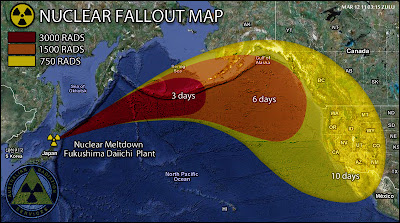 | ||
that's_offensive!.
|
 |
| "Hell In A Bottle" 1986 Japan via doppelganger |
The contaminated water will quickly dissipate into the sea and is not expected to cause any health hazard. Nevertheless, the disturbing discovery points at the unexpected problems that can crop up and continue to hamper technicians trying to control the crisis.Increases in radiation from sources that are likely from troubled nuclear energy reactors in Japan.
 |
| All this talk about Asia makes me hungry |
I guess this is their response to the bombing of Hiroshima and Nagasaki
Quality District offices on
March 16, 2011 in San Francisco.
In the wake of the nuclear
disaster in Japan,
the Environmental Protection
Agency is deploying additional radiation
detectors in areas on the
West Coast to compliment
the existing RadNet system,
which measures radition levels in air.
RadNet is a nationwide network
of monitoring stations in each state
that collect samples of air, rain,
drinking water, and milk
for analysis of radioactivity.
via sacbee.com
Exposure from x-rays or gamma rays is measured in units of roentgens. For example:
* Total body exposure of 100 roentgens (or 1 Gy) causes radiation sickness.
* Total body exposure of 400 roentgens (or 4 Gy) causes radiation sickness and death in half the individuals. Without medical treatment, nearly everyone who receives more than this amount of radiation will die within 30 days.
* 100,000 rads causes almost immediate unconsciousness and death within an hour
Enjoy the weather! via jammiewearingfool.blogspot.com
 |
| looting in Japan |
A monitor in Sacramento maintained by the U.S. Environmental Protection Agency today showed slight increases in radiation from sources that are likely from troubled nuclear energy reactors in Japan.
The "beta" category picks up strontium, while the "gamma" category picks up cesium and iodine. All three are constituents typically associated with nuclear energy production.
The recent increases remain within normal background levels, the EPA said, which vary according to atmospheric conditions.
The numbers are recorded in "counts per minute," which is a way of measuring radiation levels over time and cannot be easily compared to dose levels, such as those experienced by medical patients undergoing X-ray examination.
Another monitor in Sacramento, maintained by the U.S. Department of Energy as part of the Comprehensive Nuclear Test Ban Treaty Organization, also picked up elevated radiation levels. This monitor, which is far more sensitive, detected "miniscule quantities" of the radioactive isotope xenon-133, the agency stated.
The origin was determined to be consistent with a release from the Fukushima reactors in northern Japan. The levels detected were at 0.1 disintegrations per second per cubic meter of air, which results in a dose rate about one-millionth of the dose rate a person normally receives from rocks, bricks, the sun and other natural background sources. This coincides with a similar reading March 16 through 17 in Washington state.
Xenon-133 is a radioactive noble gas produced during nuclear fission that poses no concern at the detected level, according to the Department of Energy. via sacbee.com
THE NEW YORK TIMES: Japanese Scramble to Avert Meltdowns as Nuclear Crisis Deepens After Quake: TOKYO — Japanese officials struggled on Sunday to contain a widening nuclear crisis in the aftermath of a devastating earthquake and tsunami, saying they presumed that partial meltdowns had occurred at two crippled reactors and that they were bracing for a second explosion, even as they faced serious cooling problems at four more reactors. >>> Hiroko Tabuchi and Matthew L. Wald | Sunday, March 13, 2011
via librabunda.blogspot.com image via fuckyeahbubblebutts.tumblr.com and image via blogs.indiewire.com Justin Sullivan / Getty Images
image via scoutingreality.com



